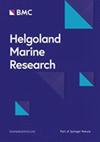谁住在哪里?北海东部大型底栖生物在沉积物类型和深度分类上的分布
4区 地球科学
Q2 Agricultural and Biological Sciences
引用次数: 5
摘要
本文对北海东部大型底栖动物的广泛数据集进行了评估,以描述水生物种在水深和沉积物中位粒度方面的分布。其中104种的丰度与水深呈显著相关,大部分物种的丰度向水文湍流的浅水区下降。这表明,对于该地区的大多数物种来说,水文是一个限制因素,而很少有物种似乎只喜欢梯度的湍流一侧。在中位粒度方面,三分之二的物种表现出显著的丰度变化,三分之一的物种没有显著的丰度变化。大多数后一种要么是数据相当贫乏,要么是已知具有高度运动性。因此,真正的沉积物通才似乎很少。相反,没有物种只局限于一种沉积物类型。在回归模型中,深度与沉积物类型的交互作用项显著,表明60%的物种在沉积物类型上的丰度分布随深度的变化而变化,表明这些种群在研究区域内被限制在其物种特有的耐受范围内。因此,这里显示的水深和沉积物类型的分布模式代表了已实现的生态位。这些数据可能有助于确定人口的位置,并且鉴于全球变化,可以作为今后比较的基线。本文章由计算机程序翻译,如有差异,请以英文原文为准。
Who lives where? Macrobenthic species distribution over sediment types and depth classes in the eastern North Sea
An extensive data set of macrozoobenthos from the eastern North Sea was evaluated in order to describe the distribution of infaunal species with respect to water depth and median grain size of the sediment. The resulting data are presented for 134 species, in 104 species abundance correlated significantly with water depth, with most species decreasing in abundance towards the hydrographically turbulent shallow areas. This suggests hydrography is a limiting factor for most of the species in this area while very few species only seem to favour the turbulent side of the gradient. With respect to median grain size, two thirds of the species showed significant abundance variations and one third did not. Most of the latter species were either represented by rather poor data or are known to be highly motile. Thus, true sediment generalists seem to be few. Conversely, no species was exclusively restricted to a single sediment type. Significant depth × sediment type interaction terms in a regression model indicate that abundance distribution over sediment types varied with depth level in 60% of the species, indicating that these populations were restricted to a part of their species-specific tolerated ranges in the study area. Hence, the distributional patterns over water depth and sediment types shown here represent realised niches. These data may help to locate populations and, in the light of global change, may serve as a baseline for future comparisons.
求助全文
通过发布文献求助,成功后即可免费获取论文全文。
去求助
来源期刊

Helgoland Marine Research
地学-海洋学
自引率
0.00%
发文量
0
审稿时长
6-12 weeks
期刊介绍:
Helgoland Marine Research is an open access, peer reviewed journal, publishing original research as well as reviews on all aspects of marine and brackish water ecosystems, with a focus on how organisms survive in, and interact with, their environment.
The aim of Helgoland Marine Research is to publish work with a regional focus, but with clear global implications, or vice versa; research with global emphasis and regional ramifications. We are particularly interested in contributions that further our general understanding of how marine ecosystems work, and that concentrate on species’ interactions.
 求助内容:
求助内容: 应助结果提醒方式:
应助结果提醒方式:


